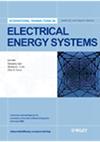Jiaming Yan, R. Liao, Lijun Yang, Jian Li
{"title":"部分放电后油浸纸绝缘材料的微观结构和电性能研究","authors":"Jiaming Yan, R. Liao, Lijun Yang, Jian Li","doi":"10.1002/ETEP.600","DOIUrl":null,"url":null,"abstract":"SUMMARY \n \nThis paper studied microstructure and its relationship with electrical properties for oil-impregnated paper insulation during partial discharge damage process. Material analysis apparatuses such as for atomic force microscopy and X-ray diffraction instrument, combined with electrical analysis apparatuses such as high-resistance meter, dielectric spectra meter, and cylinder–cylinder electrodes, were employed to investigate molecule chain structure, aggregation state structure, permittivity, dielectric loss factor, volume conductivity, and electrical strength of oil-impregnated paper insulation during the damage process. Results reveal that crystal regions of insulation paper suffer more severe damage during partial discharge damage process compared with the amorphous regions. Crystallinity exhibits an increasing trend and crystal grain orientation is enhanced, whereas crystal grain size, crystal type, and two-phase-coexistent structure are retained. Increased crystallinity and enhanced crystal grain orientation result in permittivity, volume conductivity, and dielectric loss factor decreasing, but electrical strength increasing. Changes in the activity of molecules, ions, and electrons are the results of variations of crystallinity and orientation; these are the main reasons for the change in electrical properties. Copyright © 2011 John Wiley & Sons, Ltd.","PeriodicalId":50474,"journal":{"name":"European Transactions on Electrical Power","volume":"22 1","pages":"733-746"},"PeriodicalIF":0.0000,"publicationDate":"2012-09-01","publicationTypes":"Journal Article","fieldsOfStudy":null,"isOpenAccess":false,"openAccessPdf":"https://sci-hub-pdf.com/10.1002/ETEP.600","citationCount":"6","resultStr":"{\"title\":\"Study on microstructure and electrical properties of oil‐impregnated paper insulation after exposure to partial discharge\",\"authors\":\"Jiaming Yan, R. Liao, Lijun Yang, Jian Li\",\"doi\":\"10.1002/ETEP.600\",\"DOIUrl\":null,\"url\":null,\"abstract\":\"SUMMARY \\n \\nThis paper studied microstructure and its relationship with electrical properties for oil-impregnated paper insulation during partial discharge damage process. Material analysis apparatuses such as for atomic force microscopy and X-ray diffraction instrument, combined with electrical analysis apparatuses such as high-resistance meter, dielectric spectra meter, and cylinder–cylinder electrodes, were employed to investigate molecule chain structure, aggregation state structure, permittivity, dielectric loss factor, volume conductivity, and electrical strength of oil-impregnated paper insulation during the damage process. Results reveal that crystal regions of insulation paper suffer more severe damage during partial discharge damage process compared with the amorphous regions. Crystallinity exhibits an increasing trend and crystal grain orientation is enhanced, whereas crystal grain size, crystal type, and two-phase-coexistent structure are retained. Increased crystallinity and enhanced crystal grain orientation result in permittivity, volume conductivity, and dielectric loss factor decreasing, but electrical strength increasing. Changes in the activity of molecules, ions, and electrons are the results of variations of crystallinity and orientation; these are the main reasons for the change in electrical properties. Copyright © 2011 John Wiley & Sons, Ltd.\",\"PeriodicalId\":50474,\"journal\":{\"name\":\"European Transactions on Electrical Power\",\"volume\":\"22 1\",\"pages\":\"733-746\"},\"PeriodicalIF\":0.0000,\"publicationDate\":\"2012-09-01\",\"publicationTypes\":\"Journal Article\",\"fieldsOfStudy\":null,\"isOpenAccess\":false,\"openAccessPdf\":\"https://sci-hub-pdf.com/10.1002/ETEP.600\",\"citationCount\":\"6\",\"resultStr\":null,\"platform\":\"Semanticscholar\",\"paperid\":null,\"PeriodicalName\":\"European Transactions on Electrical Power\",\"FirstCategoryId\":\"1085\",\"ListUrlMain\":\"https://doi.org/10.1002/ETEP.600\",\"RegionNum\":0,\"RegionCategory\":null,\"ArticlePicture\":[],\"TitleCN\":null,\"AbstractTextCN\":null,\"PMCID\":null,\"EPubDate\":\"\",\"PubModel\":\"\",\"JCR\":\"\",\"JCRName\":\"\",\"Score\":null,\"Total\":0}","platform":"Semanticscholar","paperid":null,"PeriodicalName":"European Transactions on Electrical Power","FirstCategoryId":"1085","ListUrlMain":"https://doi.org/10.1002/ETEP.600","RegionNum":0,"RegionCategory":null,"ArticlePicture":[],"TitleCN":null,"AbstractTextCN":null,"PMCID":null,"EPubDate":"","PubModel":"","JCR":"","JCRName":"","Score":null,"Total":0}
引用次数: 6
Study on microstructure and electrical properties of oil‐impregnated paper insulation after exposure to partial discharge
SUMMARY
This paper studied microstructure and its relationship with electrical properties for oil-impregnated paper insulation during partial discharge damage process. Material analysis apparatuses such as for atomic force microscopy and X-ray diffraction instrument, combined with electrical analysis apparatuses such as high-resistance meter, dielectric spectra meter, and cylinder–cylinder electrodes, were employed to investigate molecule chain structure, aggregation state structure, permittivity, dielectric loss factor, volume conductivity, and electrical strength of oil-impregnated paper insulation during the damage process. Results reveal that crystal regions of insulation paper suffer more severe damage during partial discharge damage process compared with the amorphous regions. Crystallinity exhibits an increasing trend and crystal grain orientation is enhanced, whereas crystal grain size, crystal type, and two-phase-coexistent structure are retained. Increased crystallinity and enhanced crystal grain orientation result in permittivity, volume conductivity, and dielectric loss factor decreasing, but electrical strength increasing. Changes in the activity of molecules, ions, and electrons are the results of variations of crystallinity and orientation; these are the main reasons for the change in electrical properties. Copyright © 2011 John Wiley & Sons, Ltd.

 求助内容:
求助内容: 应助结果提醒方式:
应助结果提醒方式:


